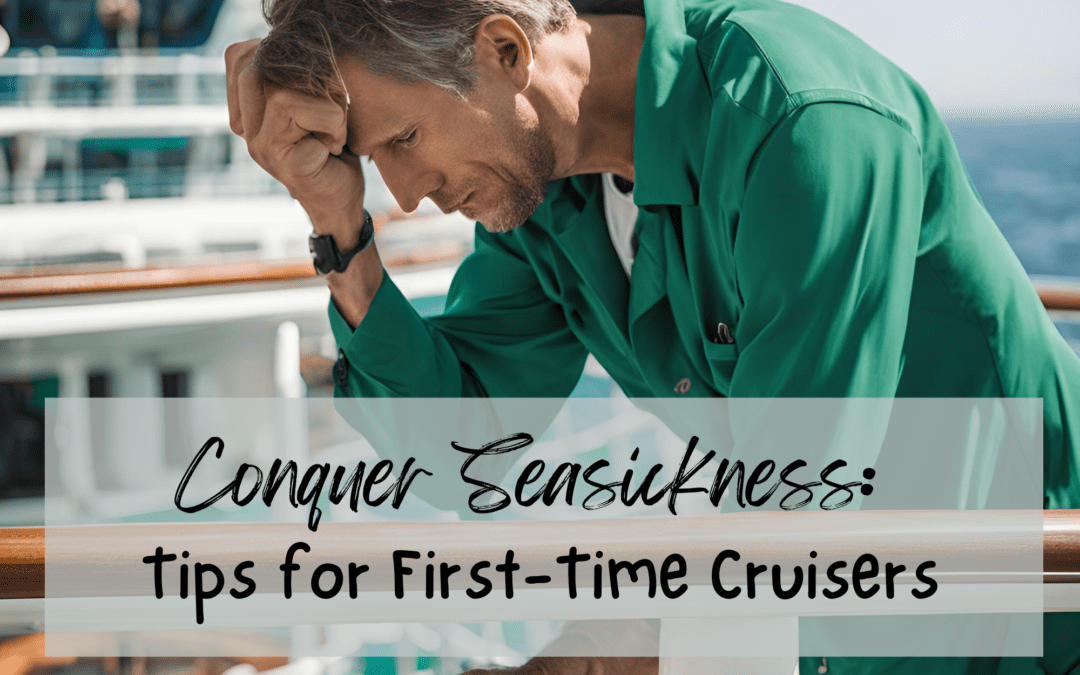Seasickness Tips for new cruisers
The Impact of Seasickness on New Cruisers
Seasickness can turn an exciting cruise into a challenging experience, especially for new cruisers. Addressing seasickness is crucial for ensuring a pleasant and memorable journey. By understanding its causes and learning how to prevent it, you can fully enjoy your time at sea.
What Our Seasoned Cruisers Say about Seasickness
“As someone who has been cruising for over a decade, I can confidently say that seasickness is manageable. On my first few cruises, I struggled with nausea, but I found that ginger tablets and acupressure wristbands worked wonders. I also made sure to stay hydrated and avoid heavy meals. Now, I can enjoy my cruises without any worries!”

David M.
Veteran Cruiser
“I was hesitant to go on my first cruise because I was worried about seasickness. However, I discovered that booking a mid-ship cabin and spending time on deck in the fresh air made a huge difference. I also used motion sickness patches, which were incredibly effective. Thanks to these tips, I now look forward to every cruise!”

Lilly P.
Frequent Traveler
“Seasickness was a big concern for me, but I found that staying active and engaging in onboard activities helped keep my mind off it. I also made sure to get plenty of rest and avoid alcohol. These strategies have made my cruising experiences so much more enjoyable. I highly recommend them to anyone new to cruising!”

Keith S.
Experienced Cruiser
Choose the Right Cabin
Stay Hydrated
Preventative Measures
Seasickness tips to prepare
- Choose Your Cabin Wisely: Opt for a cabin in the middle of the ship and lower decks for less motion. A room with a window or balcony can also help.
- Pack Your Remedies: Over-the-counter motion sickness medication like Dramamine or Bonine can be lifesavers. Try them a few days before your cruise to see if they cause drowsiness.
- Embrace Ginger: Ginger is a natural remedy for nausea. Pack ginger candies, tea, or supplements.
- Try Acupressure Bands:These can help alleviate nausea symptoms. For more in-depth tips on creating a comprehensive seasickness kit, check out our guide on [How to make your own cruise emergency kit]

Cruise Ship Size and Seasickness
5. Choose a larger ship
Larger cruise ships often offer a smoother ride. This is due to their size and advanced stabilization systems. While no ship can completely eliminate the effects of waves, larger vessels tend to be more stable.
If you’re prone to seasickness, considering a larger cruise ship might be beneficial. However, it’s important to remember that other factors, such as cabin location and weather conditions, also play a role in motion sickness.
6. Pick the right Itinerary
Seasickness tip pick the right itinerary
Choosing the right cruise itinerary can impact your seasickness experience. Certain regions are known for calmer waters, while others might be more prone to rough seas.
- Caribbean cruises during the winter months often encounter calmer waters.
- Alaska cruises can be prone to rougher seas, especially in certain areas.
- Mediterranean cruises typically offer a mix of calm and choppy waters, depending on the specific itinerary.
Researching the typical weather conditions for your desired destination can help you make an informed decision.
Onboard Strategies when seasickness hits
7. Find Your Balance: Spend time outdoors focusing on the horizon. This can help your brain adjust to the ship’s movement.
8. Eat Lightly: Opt for small, frequent meals. Avoid heavy, greasy foods.
9. Stay Hydrated: Dehydration can worsen motion sickness. Drink plenty of water.
10. Limit Alcohol and Caffeine: These can exacerbate symptoms.
11. Fresh Air: Step outside for some fresh air when feeling unwell.
12. Avoid Triggers: Reading, screens, and video games can intensify motion sickness.
Don’t under estimate these seasickness tips
13. Relax and Enjoy: Stress can worsen symptoms. Take deep breaths and relax.
14. Consult Your Doctor: Ask your doctor for advice if you have severe motion sickness.
Seasickness Tips for Children
15. Child-friendly medications: Consult your pediatrician for age-appropriate motion sickness remedies.
16. Distraction: Engage children in games, movies, or books to divert their attention.
17. Comfort: Ensure children are well-rested before the cruise and maintain a comfortable sleep schedule.

Seasickness tips on what foods to eat
18. Bland foods: Opt for easily digestible foods like crackers, rice, and bananas. Remember the BRAT diet for easy-to-digest foods for all ages.
19. Stay away from spicy, greasy, or overly sweet foods.
20. Hydration: Encourage regular water intake to prevent dehydration. (Small sips of water and ice chips. Don’t overwhelm your stomach!)
Personal Experience with food remedies to help with seasickness
Severe seasickness plagued our first cruise. The ship was in constant motion, and the sight of barf bags was commonplace. Our room steward suggested green apples as a potential remedy for nausea. He said, that’s what helped his stomach.
21. Reach for Green Apples
Non-medication remedies for Seasickness
22. Acupressure: Use acupressure bands or apply pressure to specific points on the wrist. (Remember a pair of bands is for one person)
23. Aromatherapy: Lavender and peppermint essential oils can help calm the senses.
24. Relaxation techniques: Teach children deep breathing exercises and meditation.
Medication and Motion Sickness
25. It’s crucial to understand that many prescription medications can interact with motion sickness remedies, potentially leading to unwanted side effects. To ensure safe and effective treatment, always consult your doctor or pharmacist before taking any medication for motion sickness. They can assess your specific situation and provide personalized recommendations.
Over-the-Counter Motion Sickness Remedies
26. Over-the-counter (OTC) medications can provide relief from motion sickness symptoms.
Common OTC options include:
- Antihistamines: These medications can help reduce nausea and dizziness.
Some common brands include Dramamine, Bonine (meclizine), and Benadryl. Be aware that some antihistamines can cause drowsiness. - Ginger: Available in various forms like capsules, gummies, or tea, ginger has been used traditionally to soothe upset stomachs.
- Acupressure wristbands: These wristbands apply pressure to a specific point on your wrist, which may help alleviate nausea.
Important Note: While these OTC remedies can be effective for many people, they may not work for everyone. If you experience severe or persistent motion sickness, consult your doctor for additional treatment options.

Alcohol and Seasickness tip: They don’t mix
Alcohol can exacerbate motion sickness symptoms. It’s a common misconception that alcohol can help with nausea. In reality, it often worsens the situation.
- Dehydration: Alcohol is a diuretic, which can lead to dehydration, a common factor in motion sickness.
- Impaired judgment: Alcohol can impair your judgment, making it harder to recognize and respond to symptoms.
- Increased risk of falls: The combination of alcohol and motion can increase the risk of accidents.
27. It’s best to limit alcohol consumption, especially if you’re prone to motion sickness. If you do choose to drink, do so in moderation and stay hydrated.
When to Seek Medical Attention
28. If your seasickness becomes severe or doesn’t improve with over-the-counter remedies, it’s essential to seek medical attention. The ship’s medical center has professionals who can provide appropriate treatment and relief.
For more information on handling illness while on a cruise, check out our guide on [What to do when you get sick on a cruise].
Did You Know?
When the rocking continues on land
29. Mal de Débarquement Syndrome (MdDS): Bringing the Sea Home
While most people recover from seasickness once they disembark, a smaller percentage experience a persistent sensation of motion called Mal de Débarquement Syndrome (MdDS). It’s like your body thinks it’s still on a boat, even when you’re on solid ground. Symptoms can include dizziness, imbalance, and fatigue. If you suspect you might have MdDS, consult a healthcare professional for diagnosis and treatment options. Learn more about MdDs at the American Brain Foundation.
Conclusion: How to Conqure seasickness
With a little preparation and the right approach, you can significantly reduce the chances of seasickness and fully enjoy your cruise. Remember, most people adjust to shipboard motion quickly. By following these tips, you’ll be well-equipped to conquer any queasiness and make the most of your vacation.
Ready to set sail?
Book your Carnival cruise today and start planning your unforgettable adventure!
FAQs about Seasickness
- I’m pregnant. Can I take motion sickness medication? It’s crucial to consult your doctor before taking any medication while pregnant.
- What if I’ve tried everything and I’m still seasick? If symptoms persist, consult the ship’s medical center for further evaluation and treatment.
- Can I prevent motion sickness with ginger ale alone? While ginger can help, it’s often more effective in combination with other remedies.
- Are there specific pressure points for acupressure bands? Yes, there are specific points on the wrist believed to help with nausea.
- Can I bring my own motion sickness medication on the cruise? Absolutely, you can bring your preferred over-the-counter medication.
- Will I get used to the motion eventually? Most people adapt to the ship’s motion within a day or two.
- Can I eat normally after the initial nausea passes? Gradually reintroduce solid foods, starting with bland options.
- Should I avoid certain cabin locations if I’m prone to motion sickness? Mid-ship cabins on lower decks tend to experience less motion.
- Can I use essential oils on the cruise? Yes, but be mindful of other passengers and use them discreetly.
- What should I do if I’m feeling dizzy in addition to nauseous? Find a quiet place to sit or lie down, avoid sudden movements, and stay hydrated.
- What’s the difference between motion sickness and seasickness? Seasickness is actually a type of motion sickness. Motion sickness is a general term for the discomfort caused by movement, while seasickness specifically refers to the discomfort caused by the motion of a boat. Both conditions occur due to a mismatch between what your eyes see and what your inner ear feels.
- What is Mal de Débarquement Syndrome (MdDS)? Mal de Débarquement Syndrome (MdDS) is a condition where you continue to feel like you’re moving, even after getting off a boat or other mode of transportation. It’s essentially bringing the seasickness home with you. Symptoms include dizziness, imbalance, and fatigue. While it’s not fully understood, it’s believed to be related to the brain’s difficulty readjusting to stationary conditions after experiencing motion.


